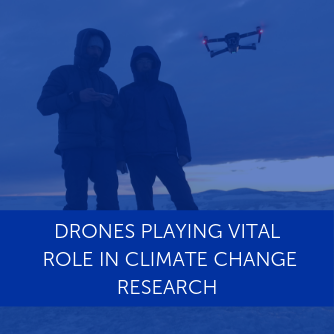
Case Studies
Drones a vital tool in climate change research
Drones are playing a crucial role in vital work to better understand the effects of climate change in the Arctic, as part of the Microsoft AI for Earth project. ... Read More
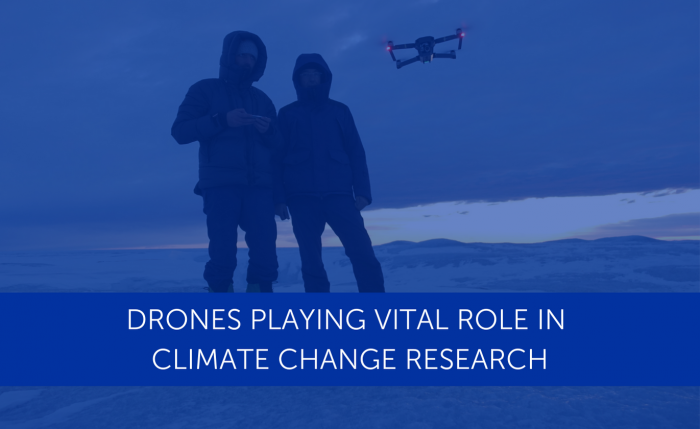
Drones are playing a crucial role in vital work to better understand the effects of climate change in the Arctic.
Dr Joseph Cook, a glaciologist at the University of Sheffield, is conducting major research projects in Greenland, exploring the impact of global warming on glacier and ice-sheet dynamics.
To help these studies, Dr Cook and his team are harnessing the power of drones, including a DJI Mavic Pro.
The UAVs (unmanned aerial vehicle) enable the scientists to access difficult-to-reach areas, cover large swathes of land and provide accurate results. They also help survey sites and check for polar bear!
As part of these investigations, Dr Cook has turned to UAV expert Heliguy for equipment and industry advice - praising the service and knowledge of our staff.
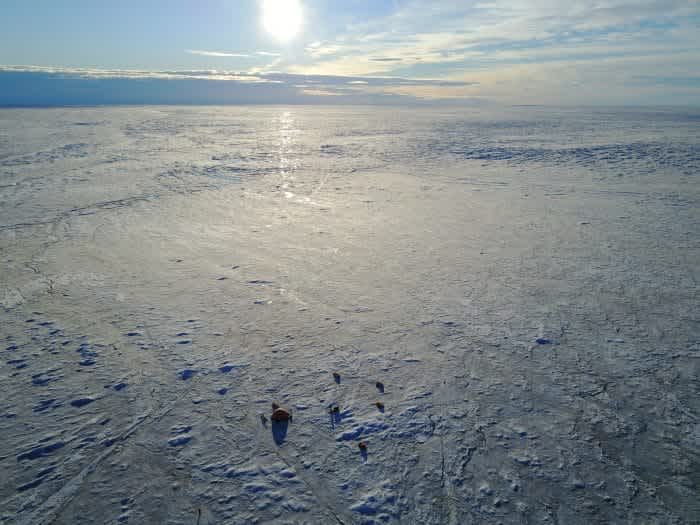
Aerial view of a field camp. Picture courtesy of J Cook / Ice Alive
Heliguy has helped Dr Cook and his team. He said: "I have bought most of my peripherals from Heliguy over the years, including batteries, props, landing gear and small consumables. I’ve always been very pleased with the service and the expertise of the staff and will keep using Heliguy in the future."
Heliguy recently interviewed Dr Cook to find out more about his vital work in the Arctic and to learn about how drones are playing an important role in the research.
To The Poles - An Exploration At The End Of The Earth
Dr Cook, 32, has been working on the general theme of melting glaciers since 2005.
This experienced glaciologist has mostly worked from on-ice camps on the Greenland Ice Sheet, but his research has also taken him to Svalbard, north of Iceland, and he will soon be heading south to Antarctica.
He has published 30 science papers and his work is currently supported by Rolex, Microsoft, National Geographic and the UK National Environmental Research Council. He also runs a polar science organisation called Ice Alive.
The AI for Earth project runs until early 2020 and Dr Cook aims to use drones to gather training data that can be used to train AI tools to map glaciers from space using satellite imagery
Dr Cook is currently working on a number of different projects, all of which use drone mapping to some extent. The most relevant is the Microsoft/National Geographic AI for Earth project; which puts Microsoft cloud and AI tools in the hands of those working to solve global environmental challenges and build a sustainable future.
The scientific question around climate change isn't 'is it happening?'. The scientific question is now focused on the detail - 'how fast is it happening, how long have we got to act and how should we act?' One of the key things that will determine how we act and when is understanding precisely how glaciers and ice sheets melt. Understanding the process will be key in protecting ice retreat and deglaciation.
Dr Joseph Cook
One of the areas of focus for the campaign is climate. This is where Dr Cook comes in.
He said: "This project runs until early 2020 and aims to use drones to gather training data that can be used to train AI tools to map glaciers from space using satellite imagery.
"The AI for Earth grant will help us to understand glacier and ice-sheet dynamics in a warming world.
"Drones are an essential piece of field kit," says Dr Cook
"My idea is to use a form of machine learning known as supervised classification to map ice surfaces from drone images and then at the scale of entire glaciers and ice sheets using multi-spectral data from the European Space Agency’s Sentinel-2 satellite."
Explaining why the project is important, Dr Cook added: "The Earth is heating up – that’s a problem for the parts of it made of ice. Over a billion people rely directly upon glacier-fed water for drinking, washing, farming or hydropower.
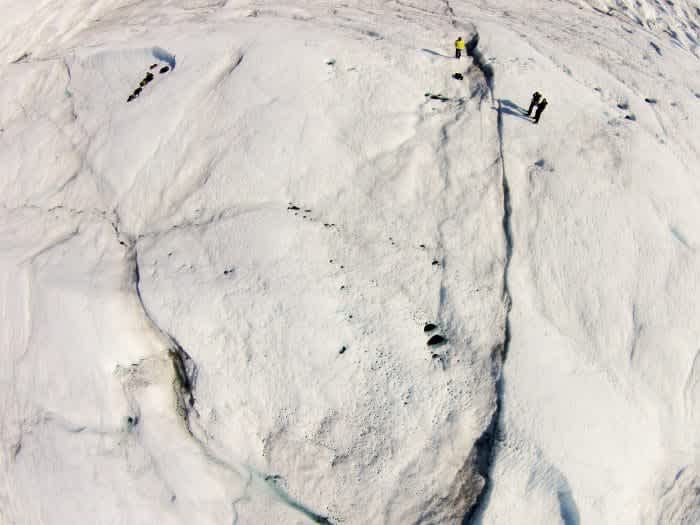
A view of the ice from above. Picture courtesy of J Cook / Ice Alive
"The sea-level rise resulting from the melting of glaciers and ice sheets is one of the primary species level existential risks we face as humans in the 21st century, threatening lives, homes, infrastructures, economies, jobs, cultures and traditions.
"The major contributing factors to a sea-level rise are thermal expansion of the oceans and melting of glaciers and ice sheets, which in turn is primarily controlled by the ice albedo, or reflectivity.
"However, our understanding of albedo for glaciers and ice sheets is still fairly basic and our ability to observe the ice surface changing over time is limited, which in turn limits our ability to make better predictions of melting and sea-level rise into the future. I hope to contribute to tackling this problem with AI for Earth."
Harnessing The Power Of Drones
As Dr Cook has already mentioned, drones are playing an important role in his research. His fleet consists of a DJI Mavic Pro and a modified Steadidrone Mavrik M with a Micasense Red Edge multispectral camera on a custom gimbal.
He said: "My basic science set-up is a small quadcopter – a modified Steadidrone Mavrik M – controlled using a Taranix XD9 radio controller and fitted with a multispectral camera. The landing gear has been swapped out for some skis to help the drone land safely on snow or uneven ice.
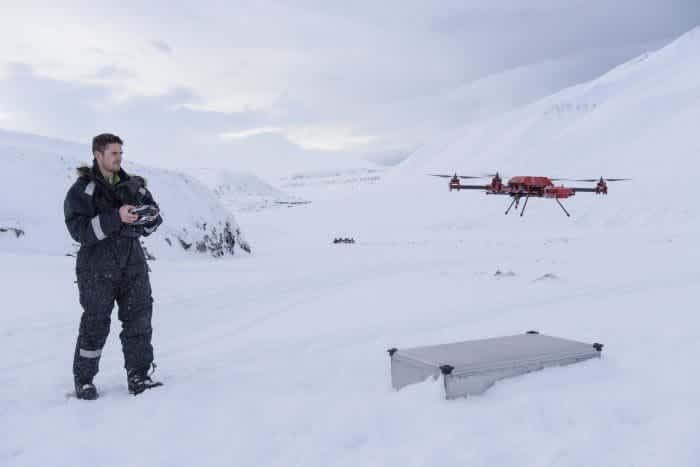
Dr Joseph Cook taking off. Picture courtesy of Rolex / Marc Latzel
"At the same time, I usually also carry a DJI Mavic Pro for popping up high to select field sites, survey the surroundings or even check for polar bear. It is also extremely useful for gathering footage for films and presentations, and wherever I need RGB images and footage instead of multispectral data."
Explaining some of the science behind his work, and how drones can contribute, he said: "I am using drones to help understand how glaciers and ice sheets melt.
"Melting ice is much more complicated than it seems – there is no simple relationship between temperature and melt rate for glaciers and ice sheets because melting is accelerated by a suite of amplifying feedbacks.
Dr Cook uses a DJI Mavic Pro to select field sites and surveying the surroundings
"One such feedback is the darkening of the glacier due to contaminants. The darker the ice becomes, the more solar energy it can absorb and the faster it melts.
"Recently, we have discovered that melting causing algae to grow on the ice surface, which in turn darkens the ice and causes more melting, causing more growth.
"I’m working on ways to map these feedbacks using drones and satellite data so we can make better predictions about how glaciers will melt in a warmer world."
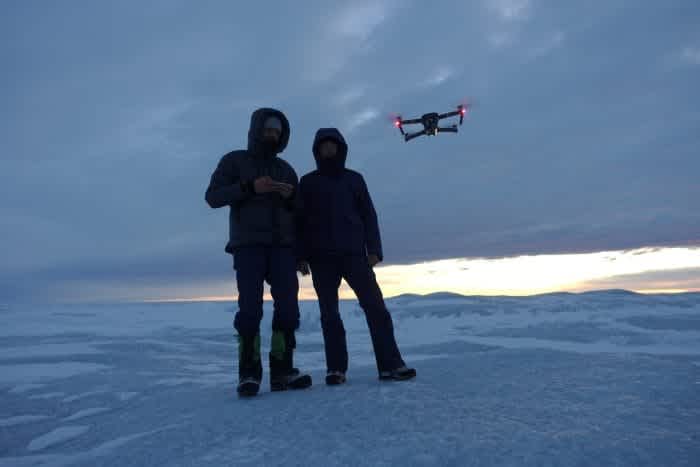
The DJI Mavic Pro in action. Picture courtesy of J Cook / Ice Alive
As well as capturing vital information from above, drones help to cover large expanses of land - with the Greenland ice sheet almost the same size as Mexico.
Drones allow greater stretches to be mapped, over and above what is achievable on foot. After all, there is a limit to how much can be discovered from the ground.
Dr Cook added: "The drone effectively adds a dimension to what we are doing. It is not just a point on the ground anymore. We can fly back and forth above a grid on the ice sheet and create pictures in different wavelengths of light that show where life is.
Dr Cook is hoping that the data collected from drone mapping will help scientists make better predictions about how glaciers will melt in a warmer world
"Drones really are an essential piece of field kit because they provide a bridge between the measurements scientists can make manually on the ground at the scale of centimetres and the measurements made by orbiting satellites at the scale of tens to hundreds of meters.
"If we only had the ground measurements, we would lack understanding of how the ice changes over space and time, and if we only had the satellite data we would lack detail of the processes operating at the surface.
"The drones allow us to combine these two data sources as they can make measurements at centimetre scale resolution but cover hundreds of meters, meaning they can be used to check the satellites are really seeing what we think they are, and also to upscale manual measurements over large spaces."
Drones Used To Capture Cinematic Shots For Educational Video
As part of the work, Dr Cook has helped to produce a 20-minute feature video, called Ice Alive.
Working in collaboration with Rolex Awards for Enterprise and Proudfoot Media, the educational piece showcases the latest research into the surprising hidden biology shaping the Earth's ice.
With the aim of creating a piece of content which was engaging for the public, as well as school and university students, Dr Cook said that the team went to great lengths to make a visually-striking feature.
To help with this, the crew used the cinematic capabilities of the DJI Mavic Pro, proving that drones can be used as a quality photographic tool, as well as for data collection.
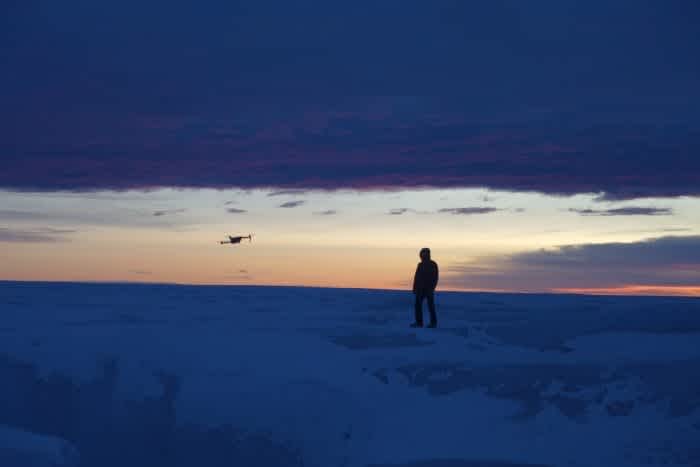
The DJI Mavic Pro in action. Picture courtesy of J Cook / Ice Alive
Dr Cook said: "The Mavic Pro was used to shoot the stunning aerial shots in the video, including tracking the team's science drone in the air to get the mesmerising shots looking down on the science drone in flight.
A drone was used to help capture eye-catching visuals for the Ice Alive video - showing that UAVs are great cinematic tools, as well as fantastic machines for collecting really accurate data
"The story is told by young UK Arctic scientists with contributions from guests including astronaut Chris Hadfield and biologist Jim Al-Khalili.
"We went to great lengths to make this a visually striking film that we hope is a pleasure to watch and communicates the otherwordly beauty and incredible complexity of the Arctic glacial landscape.
"We aim to educate, entertain and inspire others into exploring and protecting this most sensitive part of our planet in their own ways."
Flying In Harsh Environments
Drone technology has advanced at a rapid rate, allowing pilots to fly in increasingly challenging conditions. Several DJI drones have self-heating batteries for example, while some UAVs are able to stay airborne in temperatures below freezing.
This, of course, is beneficial for Dr Cook and his team. But, when it comes to harsh environments, there aren't many which are more severe than the Arctic.
Because of the weather in the Arctic, flight plans are adjusted accordingly, says Dr Cook
With this in mind, how does Dr Cook plan his missions and what does he need to consider before taking to the skies above Greenland?
He said: "Temperature is an obvious one – it is more difficult to fly in gloves and I have to be careful not to stand still flying for too long at a time. It is also a challenge to maintain a safe operating temperature for the LiPos used to power the drones. The battery life is shorter in the cold, so flight plans are adjusted accordingly.
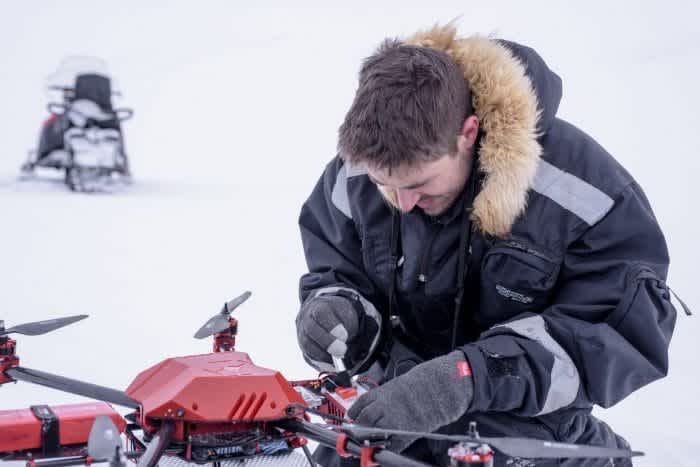
Cleaning the drone's camera. Picture courtesy of Rolex / Marc Latzel
"On glaciers, there is usually a katabatic wind (wind flowing downslope) that can be mild or very strong, so closely monitoring the local wind speed is important.
"At the same time, icing on the props, airframe and components can be a real issue, so I keep a close eye on the temperature and humidity at the field site and err on the side of caution.
"Finally, it is quite common to have no internet access, so I simply have to plan missions with waypoints in text documents and ensure all my firmware is up to date before leaving home!"
Dr Cook says that his pre-flight preparation is thorough, due to the harsh Arctic environment
So challenges do persist, but when the drone is in action, it is proving to be a vital tool for understanding this complex Arctic habitat and the impacts of global warming; an extremely important topic with future implications.
As Chris Hadfield - a former commander of the International Space Station - says on the Ice Alive video: "I think our collective understanding of the Arctic is so shallow and so inconsequential that any way we could broaden that and make people see the Arctic for what it truly is will be beneficial for the planet itself."
You can follow Dr Cook's work by visiting the Ice Alive website or follow him on Twitter/instagram via @tothepoles.
